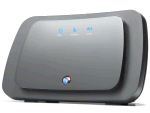
Question
I live in a big 3 storey terrace house. Will the BT Home Hub have the range?
Submitted online by David M
Our Answer
This is a tricky one to answer without more information. A Home Hub uses radio signals to communicate to computers and devices using wi-fi. These radio signals degrade over distance, can be interfered with by other electronic signals, and are attenuated by objects (such as walls and floors)
If the Hub were to be located in the centre of the middle floor of a three story house, then in most cases, the signal should cover the adjacent rooms and floors with little difficulty.
To try to calculate more precisely, more information would be needed, such as:
- The distance between the Hub and each of the points you want to reach
- Information on the material that blocks line of sight from the hub to each receiver. Materials like concrete and metal radiators are better at blocking radio signals than, say, wood.
- The level of electrical and radio interference. If in a built-up area with lots of other neighbouring wi-fi transmitters, signal quality can be adversely affected
The other factor is the type of wi-fi receiver you are using. If it’s a cheap wi-fi receiver embedded in a laptop, this may be less effective than, say, a wi-fi receiver that is fitted with an external aerial. Some wi-fi units detail how sensitive the radio receiver is. You could try checking the documentation provided with the wi-fi product to find out the radio’s sensitivity.
Improving the range
In the event that your router can’t quite cover the distance you need, then there are options, such as:
- Try the router in a different room
- Position the router away from sources of interference (computers, monitors, etc)
- Position the router so that there are less solid objects between the router and the target device
- Change the router’s channel number if there is a conflicting router on the shame channel
- Use the 802.11n standard for the router and receiver, as these offer better connectivity than the 802.11g standard
- Consider wi-fi hardware with an external aerial
As an alternative to wi-fi, you could consider Powerline Adapters (a.k.a. HomePlug adapters) that use the home’s mains wiring instead of wi-fi.